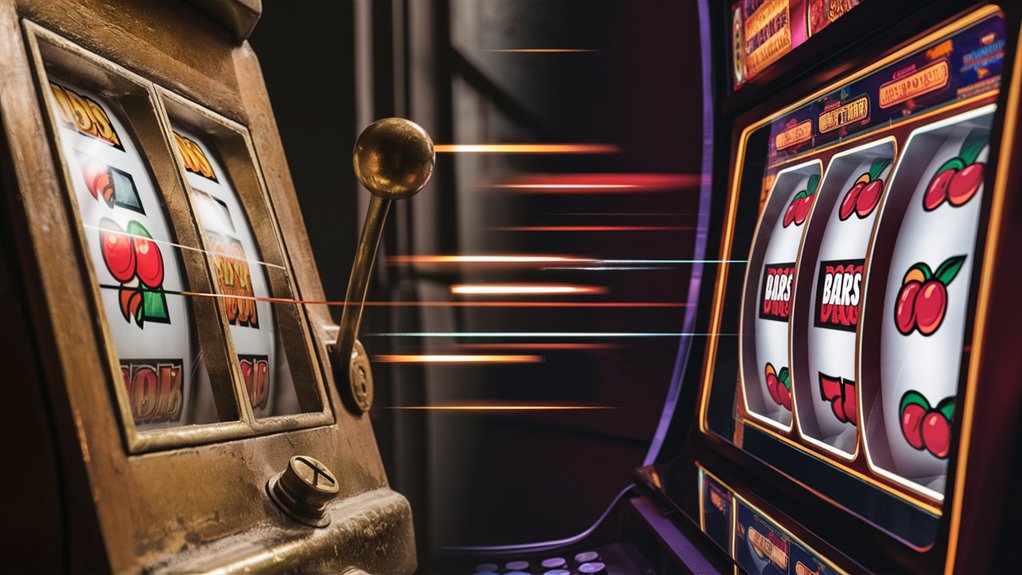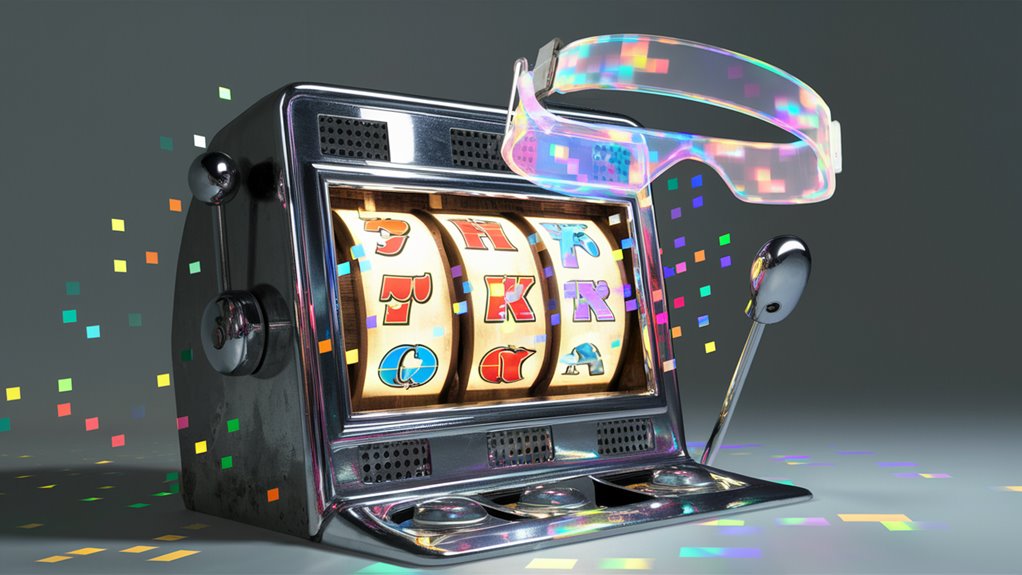
The Evolution of Slot Machines: From Physical to Digital
Early Mechanical Origins
The intriguing story of how slot machines evolved began in 1891, when the first card-based gambling machine came into being. This world-devouring invention laid the path for Charles Fey’s most famous invention, the Liberty Bell slot machine in 1895. The groundbreaking three-reels mechanical system and automated payout mechanism had now been born.
The Electromechanical Revolution
The 1960s marked a crucial turning point with the advent of electromechanical slot machines. The first wholly electromechanical slot came from Bally Manufacturing in 1964 – Money Honey featured electricitis and role of play action veritably ly, too. This leap in technology literally changed casinos from the ground up.
Digital Dawn and Video Innovation
The 1970s witnessed a further advance, with Fortune Coin developing the first video slot machines. Its technological innovation meant that mechanical reels were but a visor dumped out of its sight on one screen. It was no longer necessary to satisfy with routine expectations for games and bonus features. Random number generators (RNG) being integrated into these newer forms of amusement ensured fair play as well as gaming prospects that were far wider than anything yet experienced.
Modern Digital Transformation
The 1990s saw a leap forward in technology that had never been seen before. Important innovations included:
Bill validators for easy payments
Progressive jackpot systems that connected numerous machines
Advanced bonus features and games with more than one line at a time
An intelligent tracking system for players that enhanced gaming experience
An integrated contemporary setting
Today’s Slot Machine Technology Offers:
Mobile platform games for on-the-go entertainment
Virtual reality casino gambling experiences
Interacting via toldaro rounds
Compatibility with items on other platforms and seamless integration into them
Advanced security measures that protect both the player and operator
These advances continue to transform the gambling and amusement industry as we know it, leading to experiences that the ancient pioneers of entertainment could never have dreamed of.
In the slot machine provided with the present invention, there are five rotating drums containing a total of fifty playing card images. Each play of the machine cost only five cents to operate. The machine evaluated winning combinations against standard poker rankings.
Players made the slot machine pay off through a lever system, most likely a vestigial adjunct to their satisfaction deriving from kosher poker hands had inn. The Liberty Bell Turned
The year 1895 ushered in a breakthrough when the Liberty Bell machine was revealed by Charles Fey in San Francisco.
This innovative game of three rotating barrels contained five different easily-recognizable signature symbols: hearts, diamonds, spades and horseshoes. The machine meted out 50 cents worth at its topmost level to anyone who matched three miniature Liberty Bell symbols.
The Money Honey Revolution
In 1963 Bally Manufacturing stamped its mark on the gambling industry with Money Honey, the world’s first slot machine of any type to be completely electromechanical.
Such novel devices replaced traditional mechanical ones and added to them new mechanical and electronic elements. By eliminating the physical springs and levers–which in earlier models were of debatable reliability and served no purpose but counterposing, say, five grapes versus two cherries–this development heralded an epoch of complete reliability. Revolutionary Automatic Payout Sergeant
Most significant of Honey’s advances was its new system for automating payouts which delivered five hundred coins without human intervention.
This feature greatly increased operational efficiency and player convenience, setting new standards in casino automation. The introduction of electrical motors and components gave consistent performance and lower maintenance requirements.
The Coming of Video Slot Machines
Walt Fraley’s Fortune Coin in 1975 ushered in the next step in slot machine history with the first video slot machine.
In the beginnings, players were not all that convinced, but due to these new video slots, lowly electronic gaming machines from Japan very soon began to make an appearance on the Las Vegas Strip and sparked modern day digital casino technology.
VIDEO SLOTS TAKE OVER
THE RISE OF VIDEO SLOT MACHINES: A GAMING REVOLUTION
THE BIRTH OF VIDEO SLOT TECHNOLOGY
Fortune Coin’s video display technology Top Casino Scandals You Won’t Believe marked the beginning of the video slot revolution, with casinos continuing to spread across the floor throughout the late 1970s and early 1980s.
In turn, major manufacturers such as Bally and IGT jumped aboard, each launching their own video-based machines by 1981. Despite initial player reluctance toward these “screenless” games, improved graphics and bonus features quickly found a public eager for their novelty.
THE EVOLUTION OF MULTILINE GAMING
Multiline video slots, introduced in 1986, were a major step forward, allowing players to bet on multiple paylines simultaneously. This departure from the traditional three-reel machine revolutionized casino gaming.
Three years later, in 1989, developers unified separate bonus rounds and ‘pick-’em’ features. It fundamentally changed the way that games were played.
TECHNOLOGY ADVANCEMENTS
The first advances of the early 1990s involved bill validators and ticket-in/ticket-out systems, enhancing player convenience and reducing casino overhead. Devices these took the video slot experience from every corner of convenience store land to the heights of modern casino s.
MARKET DOMINANCE
Video slots become a runaway market success, responsible for more than 70% of new machine installs in 1995’s major casinos. Today’s sophisticated arcade games have made inroads into all forms of gambling’s mobile platforms, with:
Several hundred paylines in motion
Progressive Jackpots
A series of attractive and varied pictures
Interactive features
High Definition resolution screens
This technological revolution made video slots the industry standard for contemporary casino gaming, leading it forward through The Role of AI in Online Gambling innovation and player interaction.
MOBILE GAMING TRANSFORMATION

THE MOBILE GAMING REVOLUTION: HOW THE SMARTPHONE TRANSFORMED SLOT GAMING
ENTER HTML5IFY THE EXISTING LICENSED MEGAHIT SLOT GAMES FOR THIS GENERATION OF MOBILE DEVICES
A major transformation of the mobile slot gaming market took place in 2010, as big developers adapted their most popular titles for handheld platforms such as iPhones and iPads.
Html5 technology was pioneered by Microgaming and NetEnt. This allows slot games to be played throughout all devices in the same tense without downloading or installing separate apps.
Mobile Casino Innovation 2012-2015
One important area for mobile gaming to break through in the period between 2012-and 2015 was in online casino gambling.
Digital wallet integration and touch-optimized interfaces were the characteristics of these platforms.
Progressive jackpot systems moved from physical casinos onto mobile platforms, to become a connected network that reached players around millions of miles in distance.
Modern Mobile Gaming Dominance
Mobile slot gaming activity has surging above 70%
Technological advancement brings about revolutionary changes: touch-swap for spin mechanics, bonus rounds in augmented reality and social gaming all combined in a new type of play.
Touch screen interfaces have completely changed the way players interact with these machines. This means a much more enjoyable experience when compared to traditional counterparts that rely on cogs and levers.
Secure Payment Integration
By integrating mobile payment solutions Gambling Superstitions: Myths vs. Facts like Apple Pay and Google Pay, new life has been breathed into game transactions.
These secure payment gateways have accelerated deposit and withdraw procedures on mobile platforms, whilst at the same time maintaining strict security guidelines for mobile slot gaming.
Convenient payments and better in game mechanics have combined to make mobile the foremost platform on which to experience modern slot gaming.
Gambling Tracks With Virtual Reality
Virtual Reality Gambling: The Future of Online Casino Gaming
The Dawn of VR Casino Experiences
With the arrival of consumer VR in 2016, virtual reality technology transformed the landscape of internet gambling. This heralded an entirely new era for immersive casino gaming.
SlotsMillion blazed a trail as the world’s first virtual reality casino. Digital gaming environments were created in which players navigated through realistic casino floors and experienced 3D slot machines using hand controllers-a totally different way of playing games online!
Advanced Gaming Integration and Social Features
NetEnt and Microgaming, the leading software developers, added VR compatibility to their top of the line slot suites by 2018.
Modern VR Casino
Players can enjoy the incredible experience of all-encompassing immersion thanks to haptic feedback systems and spatial audio technology. Equally, with multiplayer VR environments players from all over the world can gamble in real time at virtual versions of casinos like TexasStation (the one casino almost as good as being there).
Cutting-edge hardware including the Meta Quest Pro and the PlayStation VR2 means that we are pushing the technological boundaries in graphics rendering, expanded FOV and precise motion tracking. We can look forward to a quantum leap in 온카스터디 먹튀검증 the quality and range of VR content as a result.
Casino operators integrate new elements into the gaming mix by blending the physical and digital worlds seamlessly, while blockchain ensures secure transaction processing in virtual environments. At the same time, these technical advances continue to act as the backbone of online gambling and its platforms– as virtual reality makes itself an indelible force in the history of this sector.
An Overview over VRCasino: DeSpread
Modern VR gambling brings together the advanced technology of haptic feedback and blockchain security protocols. Real-world transactions can be blended seamlessly with mixed reality integration and 3D environments on a realism scale not achieved before today. Games frequently offer overall completeness in both graphic appearance and sound effects.


